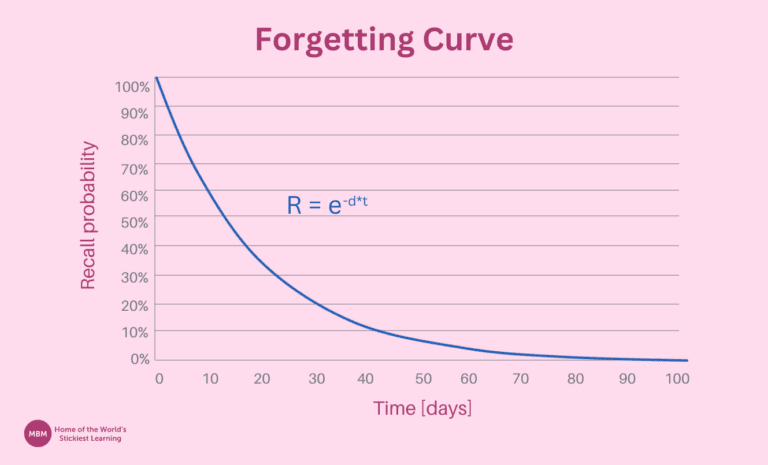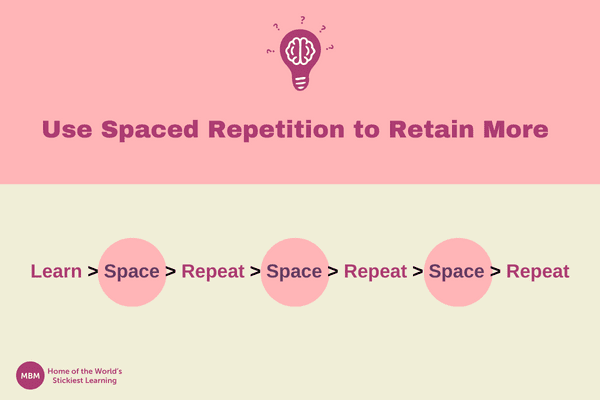We might not have liked school but the foundation of the spaced repetition schedule was the key to our success.
At school, I remember Mr Clifford every Thursday for double English. A tall and broad man with a big moustache. I dreaded it. Every minute. But what I know now that I didn’t know back then was that no thanks to Mr Clifford’s teaching of throwing a blackboard rubber at you ‘to help you to learn,’ your school education was based on an amazing piece of learning science – spaced repetition. This is the foundation of the spaced repetition schedule.
Let’s first find out about something called the Forgetting Curve and then we’ll quickly come back to the spaced repetition schedule…
Hermann Ebbinghaus and the Forgetting Curve
Hermann Ebbighaus, a German psychologist, carried out research on how we remember. He did this in the late 1800s. Ebbinghaus discovered something still talked about today in the world of learning and learning science. He called it ‘The Forgetting Curve,’ which tells us what we instinctively already know – we forget stuff over time. The longer the period the more we forget. Unless it has a particular importance, like an emotional memory, or we use it.
This is why double English was so important every Thursday because unless we used what we had learnt, we’d have forgotten it. Plus homework – oh, that’s why we got it! To embed what we had learnt. The penny only dropped some time back, and a long time after I had left school.

We recall:
- 100% in 0 days
- 94% in 1 day
- 84% in 3 days
- 81% in 5 days
- 60% in 10 days
- 37% in 20 days
- 21% in 30 days
- 12% in 40 days
- 7% in 50 days
- 5% in 60 days
- 4% in 70 days
- 2% in 80 days
- 1% in 90 days
- 0% in 100 days
Now, let’s look at the second part – the repetition schedule…
Ebbinghaus also Discovered the Spaced Repetition Schedule
Imagine making a cake. The first time you follow the recipe, the second time you sort of follow the recipe and the third time you have the recipe in front of you but it’s more of a comfort blanket than you actually need it.
What about if you made the cake 3 times, one after another? Would you have committed as much to memory? Not at all.

The spaced repetition schedule is why driving lessons are effective at helping us learn to drive. We did a driving lesson one week and then another the following week. In between the driving lessons, there was space or time to reflect. That time was for the brain to go do something else and leave the subconscious to figure it all out.
Spaced repetition hacks your brain by treating it as a bodybuilder would treat their muscle. Bodybuilders ‘attack’ the muscle with bench presses, almost breaking the muscle, and then the muscle grows between sessions before they attack it again the following week with more bench presses. And so the cycle begins – repetition with spaces in between.
If the bodybuilder were to do 3 weeks of benchpresses at once to save time, would their muscles grow quicker? No, because the muscles would stop responding. It would be less focused and less effortful.
The brain is the same, it prefers focused, effortful and meaningful learning, in order to meet its threshold of ‘I’ll hang onto this.’ The brain responds to focused, effortful and meaningful learning – spaced repetition schedule – by strengthening the connections between nerve cells.

Piotr Discovered the Spaced Schedule
Ebbinghaus was credited with the first work on the topic of spaced repetition scheduling, whilst Piotr Wozniak is credited with the Supermemo – discovering the correct pattern of remembering. Woźniak was born in March 1962 in Poland. He began to develop his spaced-repetition software after struggling to retain course material as a student at the Poznan University of Technology. The computer algorithm he built could predict the optimal time for repetitions. He called the algorithm ‘SM-2.’
Sticky Learning ® is 7 times more effective than 1-day training courses. Plus, you will get a Chain of Evidence proving your Return on Investment. Discover soft skills training that changes behaviours long term.

Optimum Learning Schedule using Spaced Repetition
Since their research, many researchers have been building on their discoveries to find the very best spaced repetition schedule. Piotr may have found it. Though algorithms are hard to understand and most of us need something simpler.
Most agree that the optimum learning schedule depends on what you are learning; how much there is, how important it is, and how complex it is. Though, there is a broad rule of thumb that can be applied that will help us all to change our behaviours. The simplified spaced repetition schedule looks like this:
- First repetition of learning: 1 day
- Second repetition of learning: 7 days
- Third repetition of learning: 16 days
- Fourth repetition of learning: 35 days
Or written another way, if you had an exam coming up your spaced schedule would look like this:
- 4 months to test – study every month
- 3 months to test – study every week
- 2 months to test – study twice per week
- 1 month to test – study 3 times per week
Spaced Repetition Schedule Example
I have been lucky enough to have been chosen as the best man 3 times. Each time is an honour, and yet the guests almost expect a comedy routine. So, it’s a testing time for anyone. Half the battle is writing a great comedic speech and the second half is remembering it so that you can deliver it with great timing, whilst relaxed, and maybe even enjoying it yourself.
My own example of spaced repetition is I have two rules for best-man speeches; A. I talk the speech through 7 times to myself, and B. I do it once per day in the 7 days leading up to the wedding. It works for me. And it seems to tie in a lot with the basic principles of repetition with spaces in between.
The Meaning of Changing Soft Skills Behaviours
We don’t need to get lost in the science, because we already know that we forget stuff over time and that after most of us have done many training courses, we know that little has changed. Shame. One day was completely wasted.
So, where does this leave us?
We can’t ignore the science and we don’t need to go too deep into it to learn more effectively and in turn change our behaviours. The messages from Ebbighaus and Wozniak are simple:
Repetition retains the information and then we need to use it.

One-day training courses have almost zero effect on changing behaviours. The best way to learn is like the phrase about the horse:
If you want to ride a horse, ride it the way it is running.
The brain wants to learn like muscles are developed in a gym. Charles Jennings called it 70: 20:10 and it is also known as blended learning. Learn by programmes, not by single training days. For example:
- First Week: Virtual classroom to understand how we learn.
- Second Week: Face-to-face training to learn the topic.
- Third Week: Using the learning at work.
- Fourth Week: Virtual classroom about how using the learnings at work went.
- Fifth Week: Face-to-face training to learn the topic.
- Sixth Week: Sharing the learnings with the team.
- Seventh Week: Virtual classroom to identify what to do next to turn the behaviours into habits.
In Conclusion, You Can Learn the Hard Way or the Easy Way
Or, as many companies do, tick the box of training by sending you on training courses knowing that little will change after you come back. Box ticked.
But there is another way, sticky learning. Your first course with us is a half day where you learn how to learn.




